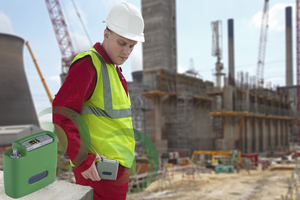

|
Edward Lowton
Editor |


|
| Home> | Health, Safety & Welfare | >Breathing safely | >Protection is vital for both workers and firms |
Protection is vital for both workers and firms
24 January 2024
In order to manage exposure to harmful airborne contaminants in heavy industry, it's vital to ensure adequate air quality monitoring and PPE provision, says Tim Turney

MANAGING EXPOSURE to harmful airborne contaminants, such as silica, is critical in heavy industrial sectors such as construction, manufacturing, and mining. Careful monitoring of the air quality and provision of the correct PPE will help prevent health risks and ensure the protection of workers, which in turn protects employers from facing costly prosecution, fines, and a damaged reputation.
Adhering to safety regulations ensures a safe, healthy, and motivated workforce and shows an employer who is focused on employee wellbeing. Where workers feel their safety is made a priority, a higher likelihood of job satisfaction leads to firms being more likely to maintain a high employee retention.
Providing effective monitoring and so protection through control measures effective is essential for workplace safety, safeguarding employee health and ensuring legal compliance while also enhancing overall workplace productivity.
Crystalline silica
Crystalline silica is a natural component of silica that can pose serious health risks such as lung cancer, silicosis, and chronic obstructive pulmonary disease (COPD) if not effectively protected against. Silica is commonly present in rocks, sand, clay and construction materials like bricks, tiles and concrete. Workers can be at risk of inhalation when carrying out tasks such as cutting, sawing, drilling, or crushing these materials.
For both parties, the best way to prevent any workplace health hazards is with effective safety protection equipment and a clear set of rules and regulations which both workers and companies should abide by, accompanied by a hierarchy of controls. This approach not only lowers the chances of workers developing health issues such as COPD but prevents the possibility of legal ramifications for employers. To understand exposure levels, thorough air monitoring of individual employees with personal sampling pumps can be undertaken. Air monitoring serves to quantify exposure levels and ensure the effectiveness of control measures while assessing any remining risks.
COPD
World Chronic Obstructive Pulmonary Disease (COPD) Day on the 15 November, is an annual event that aims to raise awareness about COPD, promote prevention and treatment, and improve the lives of people affected by this chronic respiratory and treatment. COPD is a group of lung diseases, including chronic bronchitis and emphysema, that often leads to breathing difficulties, coughing and reduced lung function. With COPD, less air flows through the airways, the tiny air sacs in the lungs lose their ability to stretch or are often destroyed.
COPD can be miss-associated with lifestyle factors, such as smoking, as research indicates that 1 in 4 of those suffering from COPD have never smoked. World COPD Day aims to remove this stigma and provide advocacies for all those affected by the disease, it also allows firms to share what regulations they have set in place to avoid others from contracting such illnesses.
Correct equipment, calibrated properly
Personal sampling pumps, like the Apex2, should comply with ISO 13137:2013 standards. These standards establish limits for flow stability and pulsation levels, ensuring consistent flow rate assessment. Adhering to these standards minimises the impact of environmental factors like air pressure and temperature on air sampling accuracy.
Using properly calibrated equipment and understanding its limitations are crucial in accurate air monitoring, particularly when dealing with substances like crystalline silica. Low pulsation pumps, with pulsation levels below 11%, following ISO standards, guarantee reliable data collection, especially when sampling for respirable Crystaline silica.
Workers and Firms
The Breathe Freely Construction campaign, launched in 2015 and led by BOHS in partnership with the Health and Safety Executive (HSE), Tideway, Landsec, Mace and Constructing Better Health found that in 2019/20, there were 3,500 occupational cancer deaths linked to construction workers, from past exposure to airbourne hazards. The HSE also estimated that there were 537 deaths in 2021 with asbestosis mentioned on the death certificate.
With responsible employers’ collaboration with HSE guidelines, awareness can be raised of the life-changing respiratory conditions.
Tim Turney is global marketing manager at Casella
For more information:
Tel: 01234 844100
- Achieving high level service status
- Noise dosimeters redeveloped
- Addition of voice recording functionality
- Level meters
- Dust sampling pumps
- Noise monitoring course
- Free second noise dosimeter
- Ptb approval for calibrator
- Identifying hazards & ensuring compliance
- Casella announces exciting autumn/winter noise and dust measurement offers


















